Kth Study guides, Class notes & Summaries
Looking for the best study guides, study notes and summaries about Kth? On this page you'll find 292 study documents about Kth.
Page 4 out of 292 results
Sort by
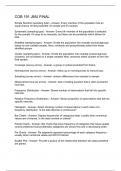
-
COB 191 JMU FINAL
- Exam (elaborations) • 3 pages • 2023
-
- $9.99
- + learn more
Simple Random (sampling type) - Answer- Every member of the population has an equal chance of being selected -it's simple and it's random. Systematic (sampling type) - Answer- Every kth member of the population is selected for the sample. It's easy to do manually, but there can be periodicity which allows for bias. Stratified (sampling type) - Answer- Divide the population into mutually exclusivegroups based on one variable (strata). Next, randomly and proportionally select from those s...
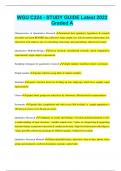
-
WGU C224 - STUDY GUIDE Latest 2023 Graded A
- Exam (elaborations) • 16 pages • 2023
- Available in package deal
-
- $10.49
- + learn more
Characteristics of Quantitative Research numerical data (quantity); hypothesis & research procedure are stated BEFORE data collection; large sample size; rely on statistical procedure; low interaction with subjects; rely on controlling, measuring, and generalizing; objective by nature Quantitative Methods/Designs survey research; correlational research; causal comparative; experimental; single subject experimental Sampling techniques for quantitative research simple random; stratified; c...
KTH 220 Theme 1-6: very detailed summaries including legislation and case law.
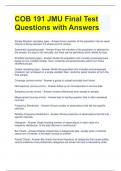
-
COB 191 JMU Final Test Questions with Answers
- Exam (elaborations) • 3 pages • 2023
-
- $13.49
- + learn more
COB 191 JMU Final Test Questions with Answers Simple Random (sampling type) - Answer-Every member of the population has an equal chance of being selected -it's simple and it's random. Systematic (sampling type) - Answer-Every kth member of the population is selected for the sample. It's easy to do manually, but there can be periodicity which allows for bias. Stratified (sampling type) - Answer-Divide the population into mutually exclusivegroups based on one variable (strata). Next, ra...
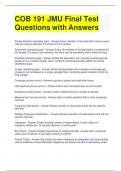
-
COB 191 JMU Final Test Questions with Answers
- Exam (elaborations) • 3 pages • 2023
-
Available in package deal
-
- $13.49
- + learn more
COB 191 JMU Final Test Questions with Answers Simple Random (sampling type) - Answer-Every member of the population has an equal chance of being selected -it's simple and it's random. Systematic (sampling type) - Answer-Every kth member of the population is selected for the sample. It's easy to do manually, but there can be periodicity which allows for bias. Stratified (sampling type) - Answer-Divide the population into mutually exclusivegroups based on one variable (strata). Next, ran...
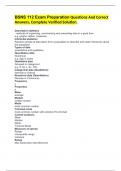
-
BSNS 112 Exam Preparation Questions And Correct Answers, Complete Verified Solution.
- Exam (elaborations) • 8 pages • 2024
-
- $11.98
- + learn more
BSNS 112 Exam Preparation Questions And Correct Answers, Complete Verified Solution. Descriptive statistics - methods of organising, summarising and presenting data in a good form e.g. graphs, tables, measures Inferential statistics Random sample of data taken from a population to describe and make inferences about the population Types of data quantitative and qualitative Quantitative data Numerical e.g. Age in years Qualitative data Grouped or categorical e.g. S, M, L, XL, XXL C...
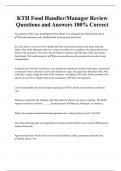
-
KTH Food Handler/Manager Review Questions and Answers 100% Correct
- Exam (elaborations) • 3 pages • 2024
-
- $5.49
- + learn more
KTH Food Handler/Manager Review Questions and Answers 100% Correct The purpose of the Texas Establishment Food Rules is to safeguard the public health and to Provide consumers safe, unadulterated, honestly presented food In a cafe, there is on server left to handle the front of the house between the lunch rush and dinner. One of the afternoon tasks is to wrap clean table sets in napkins to be kept at the hostess desk for the customers. The server has developed a routine to get this done...
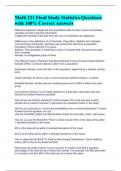
-
Math 221 Final Study Statistics Questions with 100% Correct Answers
- Exam (elaborations) • 5 pages • 2024
-
- $12.99
- + learn more
Difference between categorical and quantitative data Correct Answer Quantitative variables provide numerical information. Categorical variables yield data that can only be considered as categories. Differences in the definitions of a Parameter, Population, Statistic and a Sample Correct Answer Parameter: Numbers that summarize data from a population Population: Entire collection of a group Statistic: The probability of obtaining a result or numbers that summarize the data from a sample S...
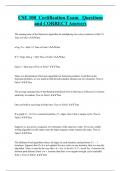
-
CSE 100 Certification Exam Questions and CORRECT Answers
- Exam (elaborations) • 14 pages • 2024
-
- $7.99
- + learn more
The running time of the Strassen's algorithm for multiplying two n-by-n matrices is Θ(n^3) True or False? False n log^5 n = Ω(n^2 ) True or False? False If f = O(g), then g = O(f) True or False? False log2 n! = Ω(n log n) True or False? True There is a deterministic O(n) time algorithm for Selection problem; recall that in the Selection problem, we are asked to find the kth smallest element out of n elements. True or False? True The average running time of the Randomized Quick-S...
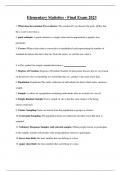
-
Elementary Statistics - Final Exam 2023
- Exam (elaborations) • 8 pages • 2023
-
- $9.99
- + learn more
Elementary Statistics - Final Exam 2023 1. What does the notation P(z<a) denote: The notation P(z<a) denotes the prob- ability that the z-score is less than a 2. point estimate: A point estimate is a single value used to approximate a popula- tion parameter 3. Z-score: When a data value is converted to a standardized scale representing the number of standard deviations the data value lies from the mean, we call the new value a . 4. s:...

That summary you just bought made someone very happy. Also get paid weekly? Sell your study resources on Stuvia! Discover all about earning on Stuvia



